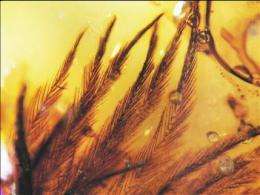Tree resin captures evolution of feathers on dinosaurs and birds

Secrets from the age of the dinosaurs are usually revealed by fossilized bones, but a University of Alberta research team has turned up a treasure trove of Cretaceous feathers trapped in tree resin. The resin turned to resilient amber, preserving some 80 million-year-old protofeathers, possibly from non-avian dinosaurs, as well as plumage that is very similar to modern birds, including those that can swim under water.
U of A paleontology graduate student Ryan McKellar discovered a wide range of feathers among the vast amber collections at the Royal Tyrrell Museum in southern Alberta. This material stems from Canada's most famous amber deposit, near Grassy Lake in southwestern Alberta.
The discovery of the 11 feather specimens is described as the richest amber feather find from the late Cretaceous period. The amber preserves microscopic detail of the feathers and even their pigment or colour. McKellar describes the colours as typically ranging from brown to black.
No dinosaur or avian fossils were found in direct association with the amber feather specimens, but McKellar says comparison between the amber and fossilized feathers found in rock strongly suggest that some of the Grassy Lake specimens are from dinosaurs. The non-avian dinosaur evidence points to small theropods as the source of the feathers.
Some of the feather specimens with modern features are very similar to those of modern birds like the Grebe, which are able to swim underwater. The feathers can take on water giving the bird the ballast required to dive more effectively.
McKellar says the Grassy Lake find demonstrates that numerous evolutionary stages of feathers were present in the late Cretaceous period and that plumage served a range of functions in both dinosaurs and birds.
The U of A team's research was published September 15, in the journal Science.
Provided by University of Alberta




















